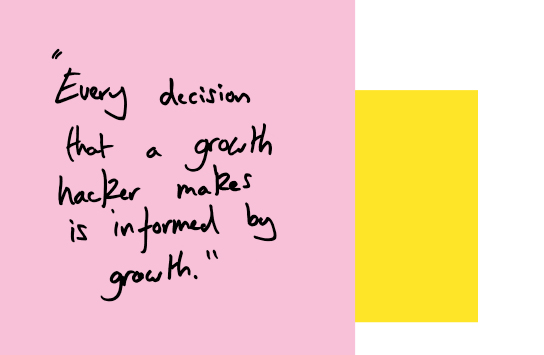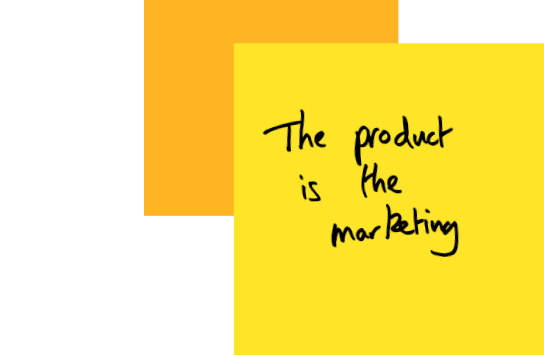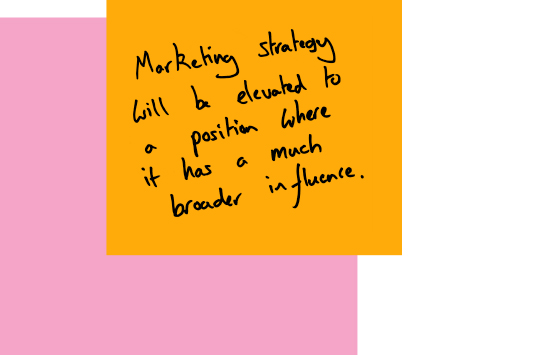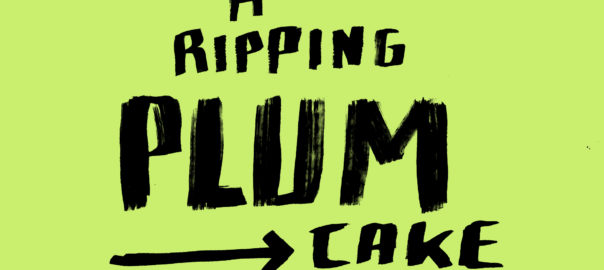POV*: Build a marketing culture, not a department
Great brands used to be built with blockbuster campaigns. The next generation of global brands are being built entirely differently. Their language is not reach and frequency but customer experience and new ways of thinking such as growth hacking. Understanding not just what they do, but how they do it, is central to unpicking their formula. To emulate them, marketing strategy must move from being the output of a department to an organisation-wide culture.
The death of blockbuster marketing
Creating a marketing campaign used to be like making a movie. It would be planned months, if not years, in advance. There was a linear process of: research, communications planning, creative development, more research, production, implementation and evaluation. Each stage of the process would take weeks, if not longer. Significant levels of resources were deployed for every element.
The risks were like making movies too. William Goldman once said of the movie business: “Nobody knows anything. Even the people in charge. It’s all a big gamble.” Despite all the research and pre-testing, it was impossible to mitigate the risk. Significant sums had to be committed to media and only when this had been invested were the returns known.
For years marketing departments and their agencies were built around this blockbuster model. Creative and strategy teams were used to having time and people aplenty for every brief. Team structures had hierarchies. Processes had checkpoints so key decisions could be referred upwards. The system was built for big-budget productions, not speed or agility.
The advent of digital media turned everything on its head. One of the interesting manifestations of this is Millward Brown’s Annual league table of global brands. It still includes names like Visa, Coca-Cola, McDonald’s, Disney and Nike. These are brands that were built in the old way, with blockbuster campaign after blockbuster campaign. However, it also contains brands like Facebook, Google, Starbucks, Zara and Amazon. These have been built in a completely different way. They’ve become global superstars in a fraction of the time their predecessors took. How many blockbuster campaigns can you recall for these brands? Identifying what they do differently is central to understanding the future of marketing.
A new mindset—Growth Hacking
The strategies being deployed so successfully by these brands are not as simple as embracing digital media. For example, many brands are currently shifting significant proportions of their budgets into content. Yet,
“In YouTube or Instagram rankings of channels by number of subscribers, corporate brands barely appear. Only three have cracked the YouTube Top 500”
(Marketing, April 2016).
Simply contributing further to people’s levels of marketing saturation is not going to yield success. To emulate their success it’s vital to understand how the new generation of brands are behaving, not just what they are doing.
One technique that sheds light on the different approaches of tech brands is growth hacking. The term was coined by Sean Ellis—a tech veteran of Dropbox, Eventbrite and numerous others—who wrote a 2010 blog post on the subject. The concept has spread throughout the tech industry and is covered comprehensively by Quick Sprout.

From all that’s been said and written about growth hacking, a number of elements stand out as being central to this philosophy:
1. Clarity of focus
Growth hackers are totally focused on growth (user acquisition) to the exclusion of all other objectives.
“Every decision that a growth hacker makes is informed by growth. Every strategy, every tactic, and every initiative, is attempted in the hopes of growing. Growth is the sun that a growth hacker revolves around”
(Quick Sprout, 9 August 2016).
This is not to say that marketeers never share this goal, but they typically will have a broader range of objectives. For example, increasing frequency or stemming a decline in users.
2. Monopolise small communities
Despite the necessity to grow fast, many tech companies do not have the financial resources of established global brands. Although many of them are relatively well fi nanced, their budgets do not stretch to global advertising campaigns. This forces them to focus on much narrower target audiences. Instead of seeking a small share of a large audience, they focus on monopolising a smaller one. One example is Etsy. The online marketplace for crafts was founded in 2005. Although eBay was already well established, Etsy’s founders spotted an opportunity to focus on a community of anti-consumerist crafters in the US. They built a loyal following amongst this audience and it was these advocates who then powered further growth through word of mouth. Ten years after it was founded, Etsy’s IPO valued it at $3.5 billion.
3. Iterate fast
The huge increase in the volume and frequency of interactions between brands and customers was covered in our last POV* piece on positioning.
Adam Sweeney of London Strategy Unit, talks about microinteractions:
“Brands as ubiquitous as Amazon, Nike and Starbucks have realised that every tiny moment that a user wants something—whether it’s to log in, to go for a jog, to relax—is a moment to assist, impress and even delight them in giving them something they want, when they want it.”
Growth hackers embrace this philosophy. Aided by their digital toolkit they are able to deploy a huge volume of activity at a rapid pace.
4. Harness data
With Growth hackers, data is not something that’s confined to the research department or used to justify activity during the end-of-year review. Analytics is central to everything they do. Everything is monitored to understand what works and what doesn’t. Split testing is used wherever possible to ensure activity is completely optimised. The insight gained is used to repeat what works and ditch what doesn’t.
These are some of the ways in which growth hacking is said to differ to traditional marketing. However, it’s debatable whether these techniques are fundamentally different to the activities of a modern marketing department: particularly the most progressive ones where big data, real time and personalisation have been truly embraced. The most interesting aspect of growth hacking is something else. And it’s something most brands have yet to get to grips with.
Culture as marketing strategy
The difference between growth hacking and traditional marketing can best be understood by looking at the outputs rather than the process. Two of the best known examples of growth hacking include:
Airbnb
As a small start-up, Airbnb needed a cheap way to promote their new service. Craigslist is an established website for classified advertisements with a huge user base, particularly in the US. Airbnb developed a hack that allowed rentals listed on their site to be automatically posted to Craigslist. This dramatically increased the exposure for their brand and led to exponential growth.
Hotmail
Struggling to find a way to promote their new email service, one of the Hotmail team suggested they automatically add a message to the bottom of every email sent using their service. It simply read: “Get your free e-mail at Hotmail”. Every time anyone sent an email they were promoting Hotmail’s brand, which kickstarted huge growth.
What’s interesting about these examples is that marketing is not something that happens to the product at the end of the process; the product is the marketing. This shift in focus is similar to the one currently taking place in customer experience in many sectors beyond the tech industry itself. Brands are realising that a great experience is great marketing.

In the US, $83 billion is lost each year due to poor and inconsistent customer experiences (IBM: The State of Marketing 2013). The advent of social media makes the fallout from poor customer service even more pronounced. The experience of British Airways highlights the issue. After the airline lost Hasan Syed’s father’s luggage he tweeted “Don’t fly @BritishAirways, their customer service is horrendous”. He then paid around $1,000 to promote the tweet, which resulted in 76,800 impressions and 14,600 engagements by the following day (Raconteur, 8 September 2015).
On the flip side, KLM are one of the brands demonstrating the power of a great customer experience. To highlight their Lost and Found service they created a video starring a dog called Sherlock. The loveable beagle accompanies staff as they tidy the aircrafts once passengers have disembarked. If any items have been left behind, Sherlock and the team track the owner through the airport and return their lost property. To have an important or treasured item returned like this is way beyond most people’s expectations of great customer service, which is reflected by viewing figures for their video—currently over 22 million on YouTube.
What’s emerging is the need for marketing to stop being confined to a single department. Marketing needs to be re-understood in its original form, as a business-wide management process. The way a marketeer thinks about understanding, attracting and retaining customers must become a philosophy that runs across every department within the business. In essence, a marketing culture should run across the whole organisation.
Stating this is easy. Delivering it is harder. It requires extensive coordination across all departments in the business—from the shopfront and the factory, to the social media and call centre teams. It requires investment in supply chains, internal systems, mobile, website and data analysis, amongst others. Many of these areas have been far from the traditional domain of marketeers.
Building a marketing culture
A number of brands are starting to take practical steps towards creating a marketing culture across their organisations. John Lewis recently promoted their Marketing Director, Craig Inglis, to the new board-level role of Customer Director. He will now oversee the end-to-end customer experience. Agencies too are creating new roles. Bartle Bogle Hegarty now have a Chief Experience Officer.
Adam Powers explains that:
“The changing landscape means that CXO must seek out additional partnerships beyond the chief marketing officer. Whether it’s with the chief innovation office, chief technology officer or others, these new creative collaborations are critical to the customer-centric business transformation that every chief executive must surely be seeking”
(Campaign, 18 September 2015).
But developing a business-wide marketing culture isn’t just a case of believing that a couple of key promotions or hires will do the trick. Indeed, marketing-centric cultures actually begin (or end) way beyond the most senior marketer. Peter Drucker’s famous quote “culture eats strategy for breakfast” contains an implicit challenge to those at the top: make sure you’re doing everything you can to foster the right beliefs, values and behaviours amongst your entire team, as in the end the buck stops with you.
For leaders looking to establish a marketing culture, three issues stand out as needing focus.
Firstly, be clear about what a marketing culture means to your business. Some businesses— FMCG or life sciences for example—are highly innovation driven. For these organisations, a culture of marketing might focus on discovering unmet consumer needs. Other businesses— retail or financial services for example— are built on customer service. A culture of marketing might focus on improving the operational elements that govern their customer service to enable them to deliver an experience that surprises and delights. Agreeing clear objectives based on an understanding of what drives success in a business is critical.
Secondly, accept that the journey is going to be long. Shifting from product- to customer-centricity requires more than a few workshops. In the case of the innovation-driven businesses highlighted above, everything from sales interactions to back-end data and CRM systems are going to have to be reimagined, their role interrogated and new operational plans laid out and implemented. This is potentially many year’s work (although quick wins will likely be achievable along the way). Accepting and articulating this upfront helps with both budgeting and team management. It will also force detailed discussions about whether the shift is right for the business, and what sacrifices the company is willing to make.
Thirdly, ensure that incentives are aligned to desired outcomes. A few years ago, a leading FMCG manufacturer was seeking to establish a business-wide culture of digital marketing excellence. They invested a great deal of effort in briefing and training their teams, but 12 months later were dismayed with the results. The reason? Existing marketers were given bonuses based on TV link test results; sales teams on key account growth; and customer service agents on call times. Not one department had any incentive to drive the change that the business sought. Realigning incentives to different outcomes is rarely popular work—people tend to have ways to ensure the existing systems work well for them—but it is essential if you want to motivate people to perform in a certain way.

At a wider level, one of the key questions as businesses move in this direction will be whether confining marketing to a single department is still the right approach. Some of its core functions might break out and become disciplines in their own right—research, product management, social media, campaign execution, for example. But marketing strategy will be elevated to a position where it has a much broader influence across every single function of the business—from the design of the product to the way it’s delivered to customers. In doing this marketing will have evolved from something done by a department to a culture or philosophy that’s practised by the whole organisation.
There’ll be many practical obstacles on the road to achieving this, but those brands that do so can look forward to a successful future.
—RG & PL
This piece was written in collaboration with Phil Lewis, Co-founder of London Strategy Unit and Director of Strategy at Albion. Phil now runs Corporate Punk, a business that challenges ambitious businesses to destroy barriers to innovation, growth and business happiness.










